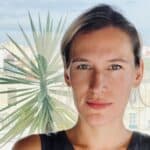WATERCRESS MEMO
✓ Watercress, also known as spring watercress, is a semi-aquatic plant that grows thanks to small roots that draw nutrients from the bottom of the water
✓ It has been consumed since antiquity for its culinary qualities as well as for its nutritional value and medicinal properties
✓ Particularly rich in antioxidants, it protects the eyes, strengthens the bones, helps regulate blood sugar, and may have anti-cancer properties
✓ It is mainly found in Europe and Japan. 40% of French production comes from Essonne
The first watercress farm in Essonne
A pretty woodland near Vayres-sur-Essonne, in the southern part of the department, provides the setting for the watercress bed where Mikaël welcomes us. Historically, there was a washhouse at this site, traces of which can still be seen. There is one imperative when you want to cultivate watercress: it’s water! In fact, a spring flows here; it gave its name to the watercress bed: Sainte Anne.
We are at the first watercress farm in Essonne, founded in 1854 for Louis Doublet. Mikaël’s family took it over in 1984. He had previously worked for an environmental consulting firm. It was during his many assignments managing water in Normandy that he witnessed the ever-increasing conversion of agricultural and natural land into housing developments and commercial zones.
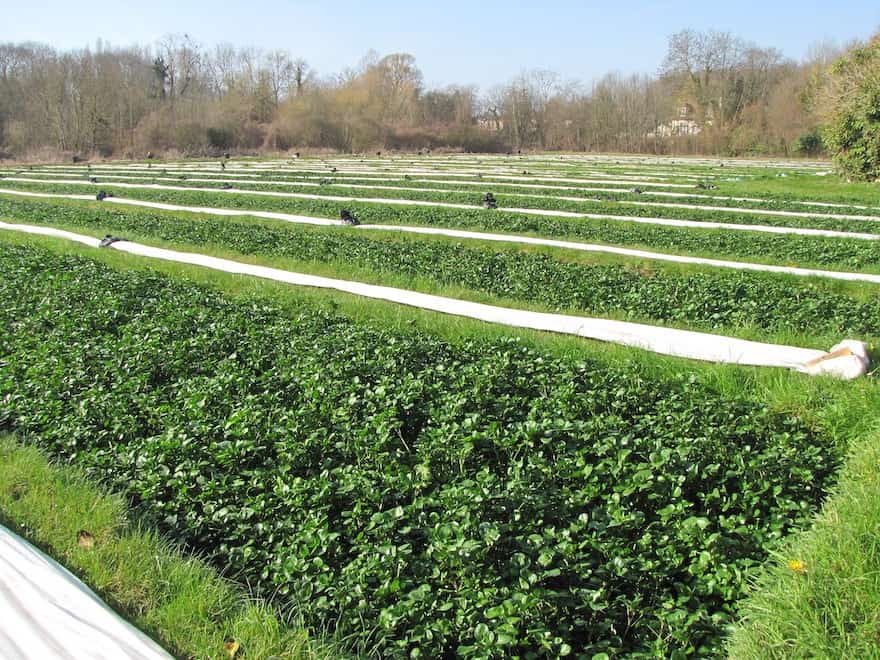
His family history (his great-grandfather was already a watercress grower!), his passion for watercress, working the land, and concern for the environment ultimately convinced him to take back the farm that had until then been run by his uncle. When the latter retired, he took over the business, becoming the fourth-generation watercress grower in the family.
Today, the Sainte-Anne watercress farm is converting to organic farming and is distinguished by the Valeurs Parc naturel régional label (which ensures that a farm’s production is part of a sustainable development approach) and produces in Île-de-France. Rhubarb is also grown there.
Mikaël produces about 40,000 bunches of watercress per year and supplies AMAPs, the Rungis market, curious visitors who come to see him, and even Michelin-starred chef Alain Passard!
Normandy is the historic birthplace of watercress in France. In the Oise in the early 19th century, Joseph Marie Etienne Cardon developed the cultivation of spring watercress. Then it was Essonne’s turn. Currently, Essonne watercress is grown on about 15 hectares. Other watercress areas are located in the Oise, Nord – Pas-de-Calais, Upper Normandy, the Lyonnais and around Agen for the largest producers.
In the 1960s, the liver fluke, a parasite, caused many farms to fail. While up to 100 producers were growing watercress in Essonne in the 1930s, there are only 25 today.

Also read the Watercress, the semi-aquatic antioxidant plant
Today, with studies to back it up, we are rediscovering the health benefits of watercress. It belongs to the Brassicaceae family, like cabbage and maca, and is therefore particularly rich in antioxidants. That’s why it’s recommended to eat it as fresh as possible, directly from the producer 🙂
Watercress cultivation, from ditches to Rungis

Mikaël starts by showing us his spring. It’s from there that he draws the water that feeds the watercress channels on his farm, which are arranged like a comb. The water flows in and out through a supply ditch that runs alongside the cultivation channels. Watercress is a purifier: as it grows, it removes nitrates from the water by converting them into gaseous nitrogen! A beautiful, majestic bamboo hedge protects the watercress from the north winds.
It’s early August, and the watercress has just been sown. It will be harvested from September to May in the 36 basins of the 5,500-square-meter farm. Mikaël harvests entirely on his own, sometimes with his father’s help. It’s a hard job: you have to be bent over the water all the time to pick the bunches and take care of them. Mikaël assures us he has a good osteopath 🙂
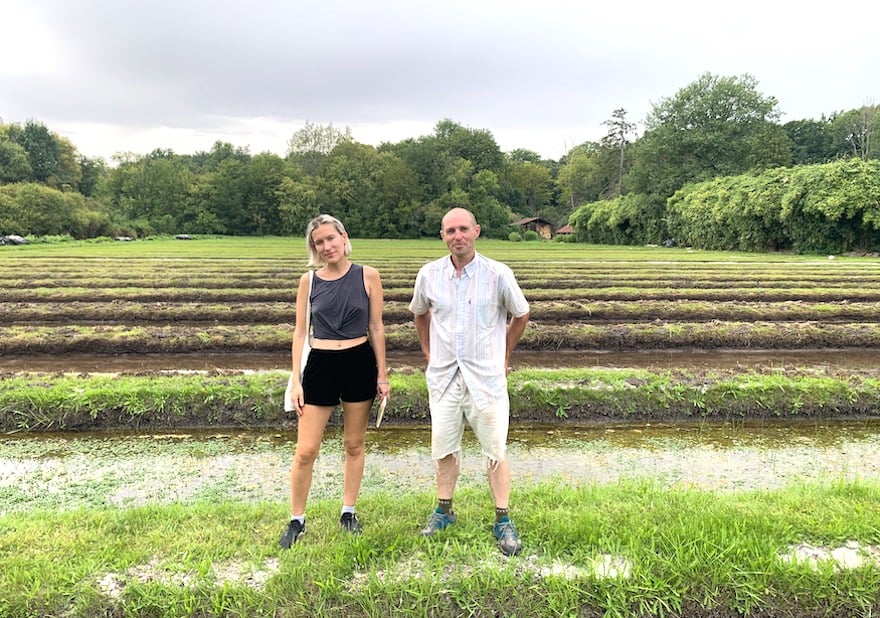
“In the past, people used to kneel on a plank; today we use snowshoes so as not to damage the watercress or the sandy bottom, and we harvest it with a knife”
When he harvests the watercress, he forms the bunches right away. The motion is second nature to him! Each bunch weighs about 300 g. We examine the leaves; some are a beautiful purplish green. He and his father have isolated a variety with violet pigmentation, the purple watercress. More attractive (chefs love it), and richer in antioxidants. The family variety was already a lovely dark green.

At the end of the season the stems are allowed to bolt, and the seeds are collected from the flowers. These are genuine farm seeds; Mikaël controls the whole process. He mixes them with sablon (Fontainebleau sand), then broadcasts the seeds for an even distribution on a moistened ditch base.
As for how to enjoy it, he gives us plenty of inspiring ideas. Watercress pesto, lemon-watercress sorbet, a strawberry-orange-watercress smoothie… “The best way to enjoy watercress is not the endless soup, it’s in a salad. You have to dare combinations: watercress, pear, beet for example.”
Three times a week, Mikaël delivers his bunches of watercress to Rungis at 3 a.m. To follow his daily life as a watercress grower, visit his Instagram account!
Transition to organic farming

Like many environmentally conscious farmers concerned with offering the best possible food for both health and the palate, Mikaël has closely considered the possibility of switching to organic farming. Despite the economic difficulties this entails at first and the changes in skills and techniques required for the transition, he embarked on the adventure last year.
So far, his production has lost 25% of its yield, but he’s holding on. “It’s a hard job but a rewarding product,” he tells us.
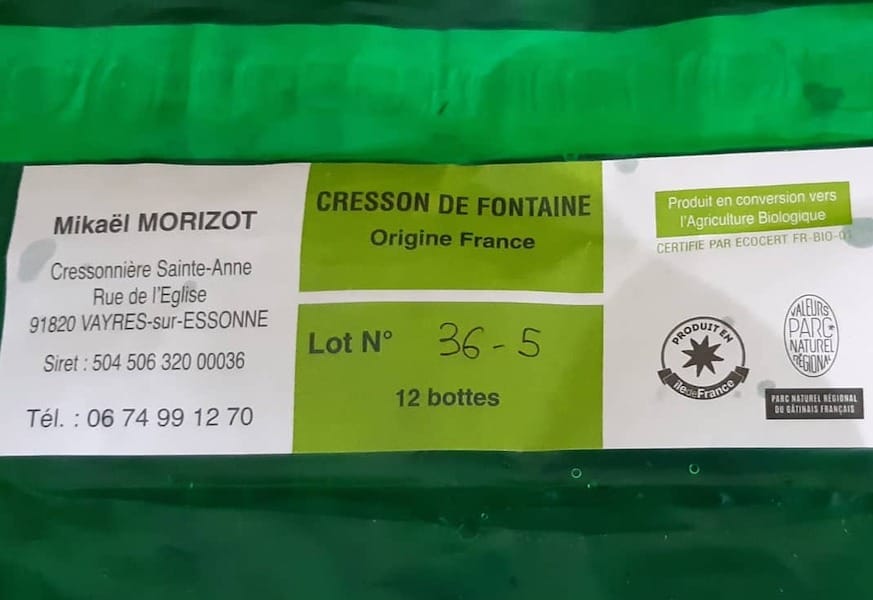
Transitioning to organic farming requires many changes:
- Alimenter les sols avec des engrais organiques et minéraux
- Utiliser des pesticides naturels : du purin d’ortie et un macéra huileux d’ail
- Utiliser des remèdes homéopathiques appliqués à l’agriculture
- Employer des toiles de paillages pour étouffer le cresson restant après récolte et nettoyer les fossés
This conversion had the immediately visible effect of increasing the microfauna in the ditches: freshwater amphipods (gammarus), woodlice, caddisflies, mayflies… And that’s good news, because these insects and other crustaceans are excellent bioindicators.
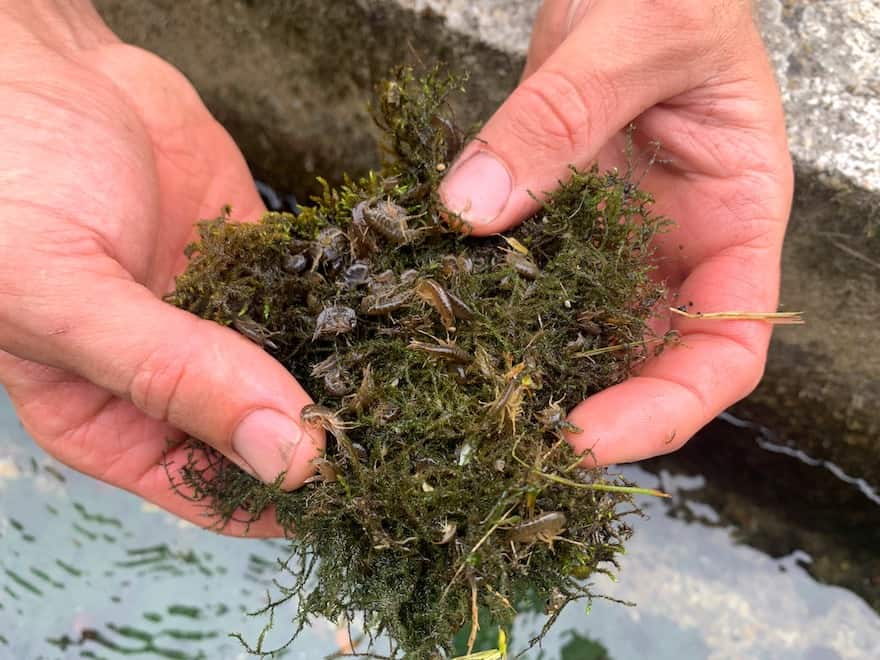
The presence of gammarus, for example, a kind of freshwater shrimp, attests to the good quality and purity of the water. This animal is often used to determine the pollution level of a watercourse: if it is polluted, gammarus stop feeding and reproducing. Mikaël takes a bit of moss from a ditch: it’s teeming!
The flip side of all these efforts is that he can already raise the price of his watercress, going from €1.30 to €1.80 per bunch.
Mikaël didn’t just give us a tour of the place, he also spoke at length about the history of watercress in France, with documents and archival photos to illustrate! Passionate and generous, he makes his love for nature a daily commitment 🌳 🌳 🌳

